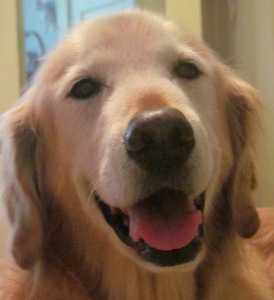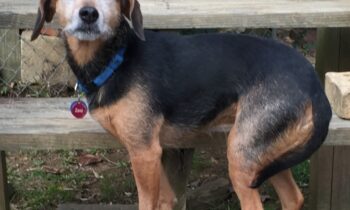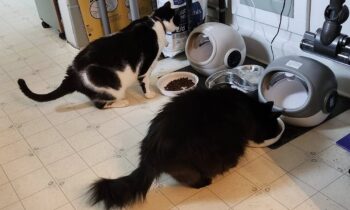
Food Puzzles
You can buy wonderful, sturdy food puzzles online or from your favorite pet supply store, and they’re well worth the investment. But don’t think you have to spend a fortune to provide your dog with a stimulating and rewarding food game! Instead, assemble some inexpensive items you can find at dollar stores or charity outlets, and make your own. Here’s what you need:
- Muffin tins
- Tennis balls
- Dog treats
- Fill each cup in the muffin tin about two-thirds full with a mixture of high-value treats (cheese, tube meat, apple or carrot pieces, for example) and some of the dog’s regular kibble.
- On top of each cup of treats, place a tennis ball.
- Set the muffin tin carefully on the floor so you don’t spill the treats or the balls, and call your dog into the room.
- Give your release word (“Okay!”) or another cue that you use consistently to tell the dog, “You may now search for food.”
- Stand back and watch without comment.
Timid or cautious dogs may be reluctant to interact with the puzzle, so make it easy! To begin with, leave several piles of treats uncovered by tennis balls. You can even make a “track of treats” on the floor around the muffin tin to encourage the dog to start munching. Once those easy-to-get treats have been eaten, the dog will likely be a bit more pushy about finding the rest.
(One reason to use high-value treats like tube meat, cheese, or peanut butter is that those treats have a much stronger smell than kibble does to most dogs. Should that not hold true for your dog, figure out what treat smells do attract his interest, and use those treats as most highly valued.)
Dogs that are unsure of how to proceed with the puzzle may look at you as if to say, “What’s up? What am I supposed to do? Is this weird metal thing with balls going to hurt me? Where’s the food?” Show the dog through your body language and facial expressions that you are happy with his interest and that you are not going to punish him for interacting with the puzzle. And once he does interact, be careful not to scare him away by exploding in praise! Yes, you’re glad for his interest, but don’t call his attention back to you by hand-clapping or loud congratulations. If you speak at all, make it calm and quiet, using general verbal praise like, “Good job,” or repeating the cue you gave initially, your version of “You may now search for food.” For example, you might say: “Good Search for Food!”
Confident and curious dogs may have a very different reaction—they may stomp on the muffin tin, sending tin, tennis balls, and treats flying! Again, don’t express your surprise loudly. There is no wrong way to solve the puzzle. Allow your dog to run around like crazy, searching out the scattered treats until they’re gone. Maybe then he will start interacting with the tennis balls. That’s good, too!
Should he become too crazy for the venue—bumping into furniture or knocking anything but the game pieces around—it’s perfectly okay to end the session. Keep some high-value treats in reserve to reward him when you call him away into another part of the house or outside.
I find it fascinating that every dog has his or her own way of dealing with food puzzles. It might be fun for you to video your dog’s first encounter with a particular game, so you can compare it with his performance once he’s had some experience. Some dogs use their paws to dislodge the tennis balls to get to the treats. Some dogs use their noses. The more they play, the more sophisticated their behavior becomes. It’s great to keep a chart of exactly how long it takes your dog to finish the game—that is, to eat every treat that was in the muffin tin. Kids might enjoy coming up with special awards for the dog at various levels of accomplishment. Involve the whole family!

Find the Food Toy
What is a food toy? It’s a pet toy that you can fill with food.
They’re manufactured for dogs, cats, and even ferrets! You can make your own, if you like, with an empty plastic jar, but I think commercially made food toys are better . . . although I personally never throw away an almost empty peanut-butter jar until my dogs have had a chance to lick away every molecule left inside.
The most well-known brand of food toys is made by KONG®, so many trainers and owners call all food toys by that name.
You will be able to find a food toy that suits the size of your dog. I prefer the giant ones because they take my large dogs some time to finish. I do have much smaller ones for my five-pounder, though! Regardless of what you put in the food toy, plan to freeze it after you fill it. Frozen food toys tend to be less messy and, of course, they last longer. They’re especially nice for puppies whose adult teeth are growing in, as the cold soothes their gums.
While your dog is learning this game, plan to add a non-frozen smelly treat to the top of the frozen goodies already in the KONG. I suggest squeeze cheese, peanut butter, or tube meat, since any of those should give the dog a strong scent to find even if the frozen contents do not. Later, as your dog perfects his game, you may find that his sniffing out a wholly frozen KONG is not a challenge!
What can fill a food toy?
- Kibble
- Dog biscuits
- Canned food
- Tube meat
- Real meat
- Sardines
- Pumpkin
- Sweet potatoes
- Carrots
- Apples
- Cottage cheese
- String cheese
- Squeeze cheese
- Peanut butter
The last three on the list are especially good for plugging the hole at the top of the KONG. (Of course, apply the same rules here as you would with anything you feed your dog—avoid foods that have caused your dog allergies or intestinal upset.)
Squish everything else down good and tight, add a bit of water to aid in freezing, and freeze until firm. When you’re ready to play, plug the top with string cheese, squeeze cheese, or peanut butter, which stay in well and are sure to attract immediate interest from your dog.
The first few times you play this game, finding the food toy should be made as easy as possible for the dog. Once you know he understands what he is looking for—that is, sniffing for—elaborate with more difficult hiding places and challenging scenarios.
- Decide before you play where you want the dog to consume his KONG. Make it simple—if you don’t want him ever eating in a bedroom, for example, don’t hide the KONG there! Once he finds it, he may want to eat it on the spot, or he may trot off with it in his mouth to consume elsewhere. Close doors or put up baby gates to keep him out of any areas where you don’t want a KONG to be eaten.
- Start with “hiding” the KONG in plain sight. Maybe in his food bowl?
- Cue him with a simple phrase like “Find your KONG,” but remember, that’s not an order. Should the dog choose not to look, even when a fully stuffed toy is waiting steps away from him, this may not be his game.
- Again, encourage with a calm and quiet body posture and a smile on your face.
- If he won’t take those steps to the KONG, change the scene—take him outside or into another room, and put the KONG back in the freezer to try again another day.
The average dog will not only take those steps, he’ll sniff out his filled KONG with great delight and begin to consume it immediately. If he’s already been enjoying KONGs in his crate, though, don’t be surprised if he takes this newly “found” one directly to the crate to eat. That’s good!
Please don’t make the mistake of attempting to pick up the full KONG he has just found to move it somewhere else for him to eat. You’ll risk triggering any resource-guarding instincts he may have, and that will not turn out well.
Once the dog is regularly sniffing out the KONG in his food bowl—then elsewhere in the kitchen or his normal eating area—expand the playing field to anywhere a filled KONG is allowed, moving farther and farther away from where his meals are served in your house. I do not recommend extending the game to the outdoors, however, because I am not comfortable with encouraging my dogs to become scavengers outside. At my house, a food toy is an inside toy—it never goes outside.
As soon as the dog learns to gallop to the KONG’s location, increase the game’s difficulty by hiding the KONG in an open paper bag, then a closed paper bag, under newspaper or a towel. (Do not, please, encourage the dog to savage your furniture by hiding a food toy under couch pillows or on a table. Consider the precedent you’re setting by “telling” the dog it’s okay to forage for food under the sofa or on top of the TV! Let your kids suggest hiding places, but keep the final choices up to the adults in the family, okay?)
Remember not to schedule any food game right before or right after a meal—although you may substitute a food game for a meal. Make sure that your dog ends each day having consumed approximately the same amount of food as he ate the day before. In other words, if food games are played in addition to meals, his meals should be proportionately smaller.
Safety with food games is also critical. Do not allow children to be near the dog while he is working on a food puzzle or food toy. They should never interfere, even if it’s to “help” the dog. Food puzzles and searches for food toys are not games for children to join in! Instead, use the opportunity to talk with the kids about what they observe while the dog is accomplishing his task. You’ll get some great insights into how your children imagine dogs think and problem-solve!



